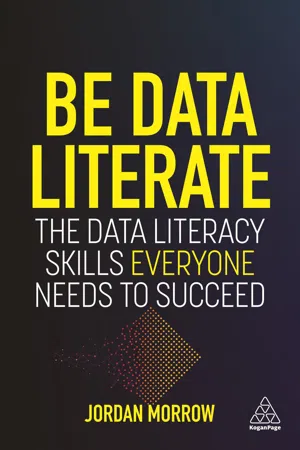Business
Data-driven Decisions
Data-driven decisions refer to the process of making informed and strategic choices based on the analysis of relevant data. This approach involves using quantitative and qualitative data to identify trends, patterns, and insights that can guide decision-making. By leveraging data, businesses can enhance their operational efficiency, improve customer experiences, and gain a competitive edge in the market.
Written by Perlego with AI-assistance
Related key terms
1 of 5
9 Key excerpts on "Data-driven Decisions"
- Vicki L. Sauter(Author)
- 2011(Publication Date)
- Wiley(Publisher)
Once the organization has identified that attribute, they apply "extensive data, statistical and quantitative analysis, and fact-based decision making to support the selected capabilities" (p. 9). Analytics are an important part of the decision support provided to decision makers. In the language of this book, the analytics are the results of the interaction between the models and the data. They are something provided to the decision maker to help him or her make a decision. However much we might want analytics because of their straight- forwardness and their predictive capability, analytics are not the only output of a DSS. In 2009 Accenture conducted a survey of its users and the information upon which they make their choices. This study of 254 large companies in the United States and 257 large 58 DECISION MAKING companies in the United Kingdom showed that on average about 40% of the information used in high-level decision making does not rely upon analytics. When queried about their use, 61% of the respondents indicated they relied on qualitative data because good data were just not available, 61% indicated that there were no past data for the decision (an innovation), and 55% said their decisions were based on qualitative and subjective factors. When asked when they do rely on analytics, respondents indicated that they use analytics (instead of qualitative information) for 71 % of decisions involving operational performance, 63% of the decisions involving pricing strategies, 48% of the decisions for asset acquisi- tion, 43% of decisions involving customer retention, and 26% of the decisions of talent management. As we have discussed and will discuss more, there are times when it is appropriate to consider qualitative data. For example, when there are no past data, as in the case of innovation, you cannot use analytics; those decisions are best supported by qualitative models.- eBook - ePub
AI Factory
Theories, Applications and Case Studies
- Ramin Karim, Diego Galar, Uday Kumar(Authors)
- 2023(Publication Date)
- CRC Press(Publisher)
ITF, 2021 ).When data are analysed using artificial intelligence (AI) technology, the data maturity level of the organisation has a significant impact on the reliability of the analytics services and achievement of overall business goals. Data maturity often refers to the capabilities of a data consumer, for example, an organisation, to utilise data produced by a data provider.Four levels of data maturity are the following (Onis, 2016 ):- Data aware: manual compilation of non-standardised analysis.
- Data proficient: data islands are available.
- Data confident: data are used in critical decision-making processes.
- Data-driven: no decision is made without data.
These phases of data maturity in an organisation reflect not only the technology maturity but also the business maturity in utilising data as an asset in the organisation’s value-creating process (Karim et al., 2021 ).5.1.1 Data-Driven Decision-Making
Once gathered, data should be used wisely. Data-driven decision-making (DDDM) is defined as using data to facilitate strategic decisions that align with pre-set goals and objectives. When organisations realise the full value of their data, better decisions will inevitably be the result. This requires the following:- choosing the appropriate analytics technology;
- creating a culture that encourages critical thinking and curiosity;
- developing data skills through practice and application;
- making data accessible;
- maintaining proper security; and
- developing proficiency by creating training and development opportunities for employees to learn data skills.
5.1.2 The Process of Data-Driven Decision-Making
Through the process of DDDM, data are used to assess, test, and improve a program, activity, or strategy. These activities occur in four iterative stages, as summarised in Figure 5.1 (Keating et al., 2018 - Jim Keogh(Author)
- 2018(Publication Date)
- De|G Press(Publisher)
Business intelligence is an umbrella term that describes key information that decision makers use to make decisions. It transforms data into information and knowledge used to make decisions. A business intelligence system provides the decision maker with a dashboard that enables data manipulation, data mining, and analyzing data in an organization’s data warehouse. In addition, a business intelligence system helps the decision maker monitor and analyze the organization’s performance.Data and Business Analytics
Data is the foundation of a business intelligent system and is collected and electronically stored throughout the organization during normal business operations.Data can logically be organized into a data warehouse. Think of a data warehouse as the electronic organization of all databases in an organization that can be accessed by the business intelligence system.The user interface—usually in the form of a dashboard—can access and manipulate data stored in the data warehouse in an effort to make effective decisions. The business intelligence system monitors actual performance and compares it to performance goals. The result is displayed on the dashboard.Business analytics is a component of a business intelligence system that provides the decision maker with three categories of analytics:–Descriptive analytics : Descriptive analytics in the form of scorecards and reporting to tell the decision maker what happened or is happening.–Predictive analytics : Next is predictive analytics in the form of data mining and other tools to tell the decision maker what will happen and why it will happen.–Prescriptive analytics : Last is prescriptive analytics in the form of simulation, optimization, and decision modeling to tell the decision maker what should be done and why it should be done.Technology Supports the Decision Maker
Decision making is the process of choosing one option from among two or more options for the purpose of attaining a goal. A decision can be based on principle or pragmatism. For example, we should not conclude a task until it is perfect—it is a matter of principle. However, we may never complete the task. So there is a trade-off.- eBook - ePub
Leading Schools to Success
Constructing and Sustaining High-Performing Learning Cultures
- James W. Guthrie, Patrick Schuermann(Authors)
- 2010(Publication Date)
- SAGE Publications, Inc(Publisher)
First, however, we offer a working definition. Data-driven decision making is the reliance for analyses and decisions upon systematically and reliably collected information regarding multiple performance and status characteristics of school operation. These facets can involve individual and collective student performance (e.g., academic achievement, attendance, extracurricular participation, or course taking), personnel (e.g., teacher characteristics, attendance, or professionaldevelopment status), parents (participation, attendance at functions, responses to school communication), or fiscal matters such as spending within important categories (e.g., personnel, supplies, and instructional materials).Careful collection, analysis, and use of data help schools to do the following:- Progress toward continuous student and organizational improvement
- Focus upon and establish priorities for instructional and staff development efforts and monitor individual and collective progress
- Meet district, state, and federal accountability requirements
- Develop a sense of community through sustained collective learning
Continuous ImprovementSystematic collection, analysis, and use of data can serve as a catalyst to propel organizational learning. School leaders can harness the regular information flow from data to sustain a culture of learning for both students and teachers within their schools. Data can provide leaders with continual feedback regarding mechanisms critical to supporting individual and collective learning in educational organizations. - eBook - PDF
- R. Kelly Rainer, Brad Prince(Authors)
- 2020(Publication Date)
- Wiley(Publisher)
Business analytics (BA) is the process of developing actionable decisions or recommendations for actions based on insights generated from historical data. Business ana- lytics examines data with a variety of tools; formulates descriptive, predictive, and prescriptive analytics models; and communicates these results to organizational decision makers. Business analytics can answer questions such as the following: What happened, how many, how often, where is the problem, what actions are needed, why is this happening, what will happen if these trends continue, what will happen next, what is the best (or worst) that can happen, and what actions should the organization take to achieve various successful business outcomes? There is a great deal of confusion between the terms business analytics and business intelligence. Business intelligence (BI) has been defined as a broad category of applications, technologies, and processes for gathering, storing, accessing, and analyzing data to help business users make better decisions. Many experts argue that the terms should be used interchangeably. We agree. However, for simplicity, we use the term business analytics (BA) throughout this chapter. This chapter describes information systems (ISs) that support decision making. Essen- tially all organizational information systems support decision making (refer to Figure 1.4). Fundamental organizational Information Systems such as transaction processing systems, functional area information systems, and enterprise resource planning systems provide a vari- ety of reports that help decision makers. This chapter focuses on business analytics systems, which provide critical support to the vast majority of organizational decision makers. The chapter begins by reviewing the manager’s job and the nature of modern manage- rial decisions. This discussion will help you to understand why managers need computerized support. - No longer available |Learn more
Be Data Literate
The Data Literacy Skills Everyone Needs To Succeed
- Jordan Morrow(Author)
- 2021(Publication Date)
- Kogan Page(Publisher)
Please note for this book’s purpose we are utilizing the term ‘data informed’ versus ‘data driven’. This is on purpose, but I do concede that in most cases data driven is used in the world today. The term ‘data driven’ really gained steam in the late 2010s and into 2020, and especially moved forward with the onslaught of the worldwide COVID-19 pandemic. To be data driven means many things to many people, but ultimately it means data is strongly being used as an asset for an individual or organization. Think of it as a marathon runner using a plan to drive a strategy for a successful marathon. This is what data driven or data informed means. It means that data is helping to drive decisions and the business forward. The reason I use the term data informed over data driven is that with the term data driven one can make the mistake in thinking that the data is truly driving everything. Data informed means the data was used to help make the decision, but is combined with other things, like the human element. This distinction matters as it is powerful.To help us understand data informed decisions and their combination with data literacy, we will be digging into our entire bag of tricks of data literacy. We will start by defining the framework and its power to drive decision-making. We will be looking at the data informed decision-making framework from what may seem like all possible angles: the four characteristics of the definition of data literacy, the four levels of analytics, speaking the language of data, the three Cs of data literacy, and probably more angles. For us to get started here, we need to know the steps of the data informed decision-making framework.Steps of the data informed decision-making framework
The data informed decision-making framework we are employing for this book has six steps. Please note, there are different frameworks that exist in the world for making a decision, but for a strong decision-making framework to be deployed and used correctly, these six steps need to be incorporated in some way, shape, or form. The six steps are: ask, acquire, analyze, apply, announce, and assess. I am going to modify these from Kevin’s work a bit and name them: ask, acquire, analyze, integrate, decide, and iterate. The reason for the shift is to clarify more, directed at each purpose and understanding. Look at Figure 9.1 - eBook - ePub
Knowledge Engineering for Modern Information Systems
Methods, Models and Tools
- Anand Sharma, Sandeep Kautish, Prateek Agrawal, Vishu Madaan, Charu Gupta, Saurav Nanda, Anand Sharma, Sandeep Kautish, Prateek Agrawal, Vishu Madaan, Charu Gupta, Saurav Nanda(Authors)
- 2022(Publication Date)
- De Gruyter(Publisher)
It integrates business analytics, data mining, data tools, knowledge management, data visualization, warehouses, OLAP, infrastructure, and best practices that help firms to make more Data-driven Decisions. These tools and techniques are not only providing the ability to get required information but also to turn them into suitable intelligence bases that will increase an enterprises’ competitive position. The business intelligence includes various technologies, practices, applications, and systems which are used to handle and analyze data to help the business enterprises to understand their market, customers, and business opportunities and well-timed business decisions. Scholars define the decision support system in numerous ways. For instance, Yun et al. [ 6 ] define it as the “combination of the information system and decision-making technology.” It is a kind of information systems that helps humans for the complex decision-making processes [ 7 ]. The decision support systems enable executives and professionals to understand what information is required, when it is required, and in what form it is needed in order to make smart business decisions. Usually, the decision support systems are used to plan, manage, and support the operational levels of business activities wherein this involves ranking, sorting, and suggesting the best among alternative business options. Scholars and practitioners agreed that the business intelligence and analytics to expose valuable information to business decision-makers across various levels of an organization to make superior, and more meaningful decisions [ 8 ]. Therefore, today the business intelligence systems and data-driven decision support systems have moved the businesses toward more intelligent enterprises. Accordingly, the business intelligence enhances the enterprise’s efficacy in handling information for decision making that integrates people, technology, and processes within the enterprise - eBook - PDF
Business Statistics
For Contemporary Decision Making
- Ken Black(Author)
- 2020(Publication Date)
- Wiley(Publisher)
8 Because big data sources are too large and too complex, new questions have arisen that cannot always be effectively answered with traditional analysis methods. 9 In light of this, 1.3 Introduction to Business Analytics 11 new methodologies and processing techniques have been developed, giving birth to a new era in decision-making referred to as the business analytics period. 10 There are other names some-times given to business analytics, such as business intelligence, data science, data analytics, analytics, and even big data, but the goal in all cases is to convert data into actionable insight for more timely and accurate decision-making. 11 For example, when applied to the business environment, data analytics becomes synonymous with business analytics. 12 Business analyt-ics provides the added value to data, resulting in deeper and broader business insights that can be used to improve decision makers’ insights and understandings in all aspects of business, as shown in Figure 1.6 . There are many new opportunities for employment in business analytics, yet there is presently a shortage of available talent in the field. In fact, an IBM survey of 900 business and information technology executives cited the lack of business analytics skills as a top business challenge. 13 Executives of today say that they are seeking data-driven leaders. They are looking for people who can work comfortably with both data and people—managers who can build useful models from data and also lead the team that will put them into practice. 14 A paper on big data released by the McKinsey Global Institute said that by the year 2018, the United States alone could face a shortage of 140,000 to 190,000 people with deep analytical skills as well as 1.5 million managers and analysts with the knowledge and skill to use the outcomes of big data analysis to make effective decisions. - eBook - PDF
Business Statistics
For Contemporary Decision Making
- Ken Black(Author)
- 2019(Publication Date)
- Wiley(Publisher)
8 Because big data sources are too large and too complex, new questions have arisen that cannot always be effectively answered with traditional analysis methods. 9 In light of this, 1.3 Introduction to Business Analytics 11 new methodologies and processing techniques have been developed, giving birth to a new era in decision-making referred to as the business analytics period. 10 There are other names some- times given to business analytics, such as business intelligence, data science, data analytics, analytics, and even big data, but the goal in all cases is to convert data into actionable insight for more timely and accurate decision-making. 11 For example, when applied to the business environment, data analytics becomes synonymous with business analytics. 12 Business analyt- ics provides the added value to data, resulting in deeper and broader business insights that can be used to improve decision makers’ insights and understandings in all aspects of business, as shown in Figure 1.6. There are many new opportunities for employment in business analytics, yet there is presently a shortage of available talent in the field. In fact, an IBM survey of 900 business and information technology executives cited the lack of business analytics skills as a top business challenge. 13 Executives of today say that they are seeking data-driven leaders. They are looking for people who can work comfortably with both data and people—managers who can build useful models from data and also lead the team that will put them into practice. 14 A paper on big data released by the McKinsey Global Institute said that by the year 2018, the United States alone could face a shortage of 140,000 to 190,000 people with deep analytical skills as well as 1.5 million managers and analysts with the knowledge and skill to use the outcomes of big data analysis to make effective decisions.
Index pages curate the most relevant extracts from our library of academic textbooks. They’ve been created using an in-house natural language model (NLM), each adding context and meaning to key research topics.








